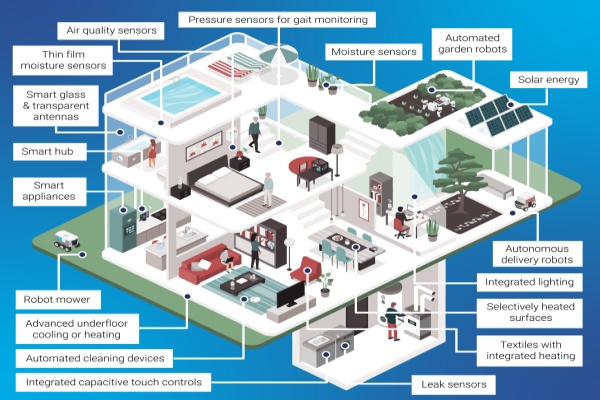House of future, full of DUMB ideas and GOOD sensors
Future homes can be smart. The problem is how.

IDTechEx recently released a report about the House of the Future. I am pretty sure that the report’s subtitle would sound like a nightmare, not an opportunity, to most people:
“Never on your own when you’re home alone”
As far as the report goes, I would summarize it with three bullets:
- Today’s homes are made smart by add-on devices, e.g. smart fridges or smart lamps. In the future, homes will be built smart. That’s why the report says “A floor that can feel when you fall, a warmth that wanders from room to room with you; could the house of the future take care of you?"
- in practice, those “smart” house of the future may well be filled in equal measures with very stupid or very smart things
- (exactly for that reason) the report is worth reading
The stupidest things include
(at least as standard features of ordinary homes, not just toys for folks with more money than brain):
- [to assist the vulnerable], pressure sensors in the floor could analyze gait to tell if the inhabitants fall or seem to be limping and could alert family, friends, or support services.
- a table with built-in electronics could sense the temperature of the drink you place down on it and heat or cool just that portion of the surface to maintain the drink’s temperature.
Translation in plain English of our real world:
- Younger generations are already increasingly UNABLE to afford buying, or even renting, any place to live, even in 50+ year old condos falling apart at the seams
- so, let’s make new homes much more expensive, for no good reason
- even when much better, much cheaper, much less polluting alternatives that would work even better already exist!
I mean, even if you had way more spare money than you could count, there are endless, much more satisfying ways to spend it than buying a table that may require maintenance any moment, instead of any good old thermos. Including buying thermos made of solid gold, or hiring a separate servant just for your thermos. And wrist-based health monitors are both way cheaper, and more accurate, than a floor may be
Then, there are really smart sensors
Forget that crap, and focus on the really interesting products in that report, that is smart sensors to apply to existing homes. Things like:
- sensors that detect water leaks, saving you thousands of Euros or repair plumbing work, applied as tape to existing walls, or as mats below any appliance working with water
- even better: moisture sensors, placed for example “behind waterproof building materials to check the efficacy of the waterproofing in showers” telling the residents that a leak started happening, and where it exactly is, without removing tiles
How to recognize REALLY “smart home” solutions
It’s simple, really, in that report or anywhere else. Is the “smart home” product you are considering to buy or fund:
- a solution of a concrete, existing problem, in ordinary homes?
- if not Open Hardware, at least based on really open standards, with service and spare parts available from multiple sources?
If the answer to both questions is yes, go ahead. If not, wait for something better.
Who writes this, why, and how to help
I am Marco Fioretti, tech writer and aspiring polymath doing human-digital research and popularization.
I do it because YOUR civil rights and the quality of YOUR life depend every year more on how software is used AROUND you.
To this end, I have already shared more than a million words on this blog, without any paywall or user tracking, and am sharing the next million through a newsletter, also without any paywall.
The more direct support I get, the more I can continue to inform for free parents, teachers, decision makers, and everybody else who should know more stuff like this. You can support me with paid subscriptions to my newsletter, donations via PayPal (mfioretti@nexaima.net) or LiberaPay, or in any of the other ways listed here.THANKS for your support!